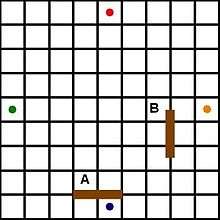Quoridor
 | |
| Players | 2-4 |
|---|---|
| Age range | 8 and up |
| Setup time | < 1 minute |
| Playing time | 20 minutes |
| Random chance | None |
| Skill(s) required | Deduction |
Quoridor is a 2- or 4-player abstract strategy game designed by Mirko Marchesi and published by Gigamic Games. Quoridor received the Mensa Mind Game award in 1997 and the Game Of The Year in the USA, France, Canada and Belgium.[1]
Rules of the game


Quoridor is played on a game board of 81 square spaces (9x9). Each player is represented by a pawn which begins at the center space of one edge of the board (in a two-player game, the pawns begin opposite each other). The objective is to be the first player to move their pawn to any space on the opposite side of the gameboard from which it begins.
The distinguishing characteristic of Quoridor is its twenty walls. Walls are flat two-space-wide pieces which can be placed in the groove that runs between the spaces. Walls block the path of all pawns, which must go around them. The walls are divided equally among the players at the start of the game, and once placed, cannot be moved or removed. On a turn, a player may either move their pawn, or, if possible, place a wall.
Pawns can be moved to an adjacent space (not diagonally), or, if adjacent to another pawn, jump over that pawn. If an adjacent pawn has a third pawn or a wall on the other side of it, the player may move to any space that is immediately adjacent to other adjacent pawns. The official rules are ambiguous concerning the edge of the board.
Walls can be placed directly between two spaces, in any groove not already occupied by a wall. However, a wall may not be placed which cuts off the only remaining path of any pawn to the side of the board it must reach.
History
Quoridor is also based on Mirko Marchesi's earlier game Blockade which was published in the 1975. Marchesi also created another version of this game called Pinko Pallino which was published in 1995 by Epta. Pinko Pallino was only for 2 players and was played on an 11×11 gameboard with a total of 42 walls and slightly different rules.[2]
Notation
Although there is no official notation, Lisa Glendenning's thesis[3] proposes a reasonable notation.
The notation proposed is similar to algebraic chess notation. Each square gets a unique letter-number designation. Columns are labeled a through i from player 1's left and rows are numbered 1 through 9 from player 2's side to player 1's side. A move is recorded as the column followed by the row as in e8. Player 1's pawn starts on e9 and player 2's pawn starts on e1.
Each pawn move is defined by the new square occupied by the pawn. For example, if player 1 moves from square e9 to e8, player 1’s move is e8.
Each fence move is defined by the square directly to the northwest of the wall center from player 1's perspective, as well as an orientation designation. For example: a vertical wall between columns e and f and spanning rows 3 and 4 would be given the designation e3v.
Games are notated as they are in chess: by the move number, player 1's move, and player 2's move. For example, a game might start with each player moving their pawn towards the goal:
1. e8 e2
2. e7 e3
And then the players might add walls to lengthen the other player's path:
3. e7h e2h
and so forth.
Strategies
- Reed opening: This opening consists in placing, during the first two moves of the game, two walls on the third row in front of the opponent with a single gap in the middle (c3h and f3h). This opening is attributed to Dr. Scott Reed (Edinburgh, UK), a known military strategist and frequent player. A counter-strategy to the Reed opening is to place two horizontal walls on the third row, one at the extreme left and one at the extreme right, which effectively reduces both players' path counts to one. The game would start as follows: 1. c3h a3h 2. f3h h3h
- Shiller opening: Both players advance their pawns three times (1. e8 e2 2. e7 e3 3. e6 e4). Then the first player places one wall vertically in the column closest to him (c7v, d7v, e7v, or f7v), providing two paths for the other player while maintaining just one path for herself. The Shiller opening implements the strategy of maximizing the opponent's path count and of minimizing one's own path count.
See also
References
- ↑ Mensa Mind Games Winners Press Release
- ↑ Pinko Pallino at BoardGameGeek
- ↑ Lisa Glendenning (May 2005). Mastering Quoridor (PDF). Computer Science (B.Sc. thesis). University of New Mexico.